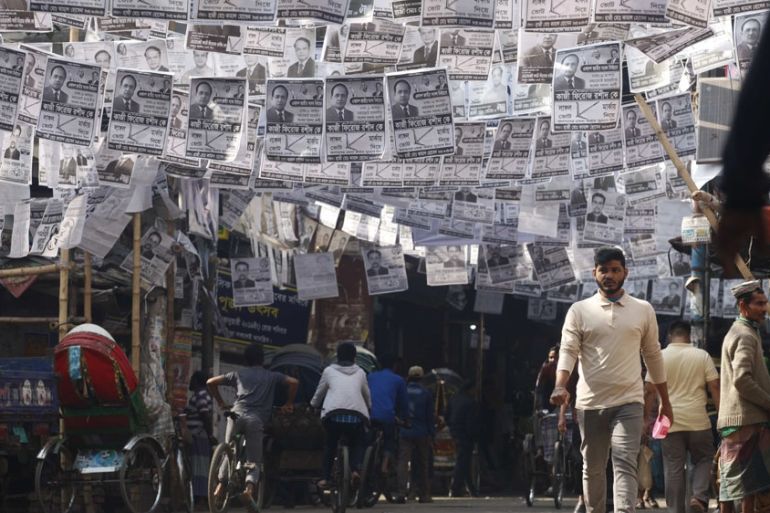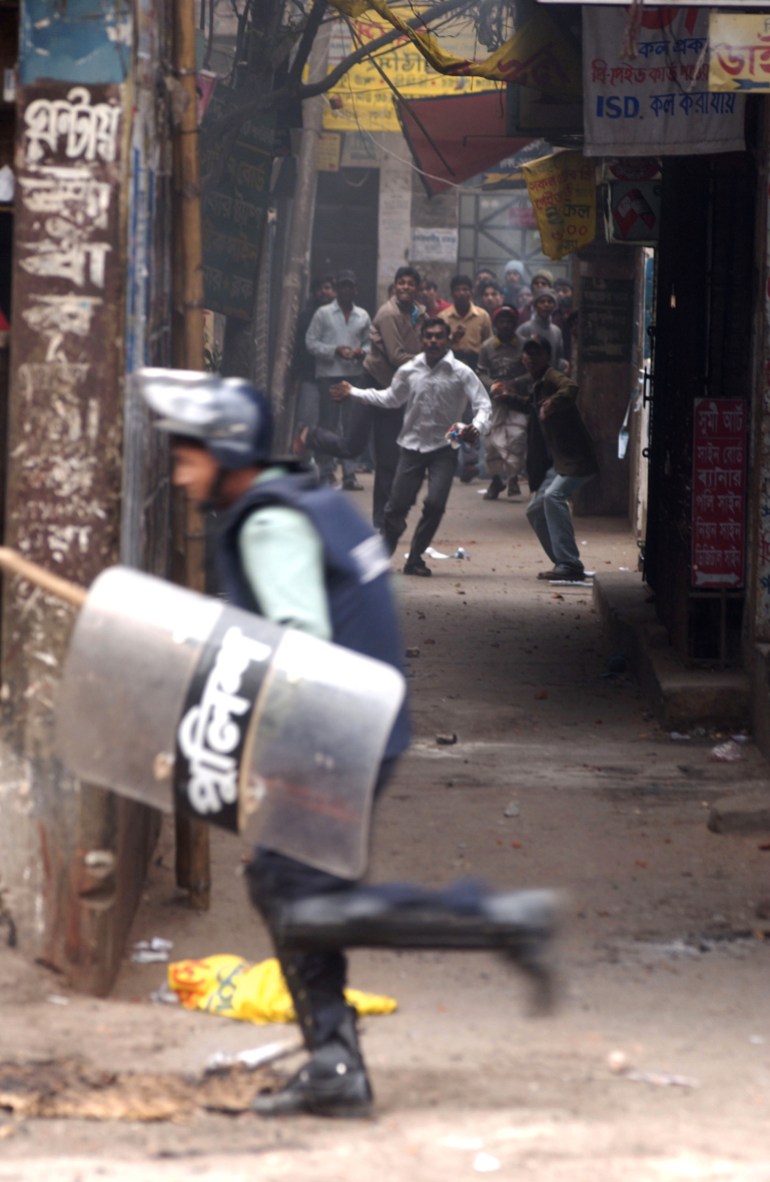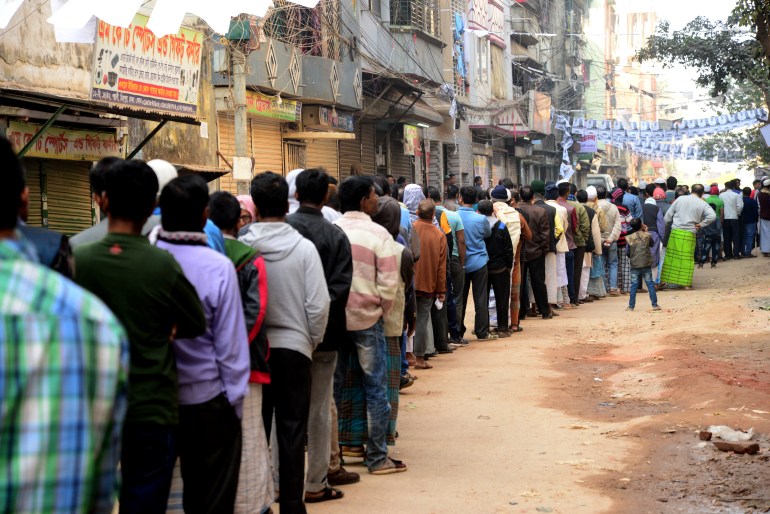Bans and boycotts: The troubled history of Bangladesh’s elections
Since independence in 1971, only a handful of the country’s elections have been considered ‘free and fair’.

On Sunday, Bangladesh, a nation of 170 million people, will go to the polls to elect a new government in the country’s 12th general election.
But in a country with a chequered history of violence and protests against dubious polls, the vote is already courting controversy.
Keep reading
list of 4 itemsApril 27, 1994: What has changed in South Africa 30 years after apartheid?
Jobless engineers, MBAs: The hidden army of Indian election ‘consultants’
Focus on southern states as India votes in second phase of mammoth election
Since 1971, when the country broke away from Pakistan, only four of Bangladesh’s 11 elections have been considered to be “free and fair”. The rest have frequently been mired in violence, protests and allegations of vote rigging.
This year, following Prime Minister Sheikh Hasina’s refusal to accept the opposition Bangladesh National Party’s (BNP) demands for a neutral caretaker government to conduct the polls, the BNP has chosen to boycott the elections. Caretaker governments have in the past delivered results generally considered credible – and, usually, a win for the opposition.
There is widespread speculation that this vote – which could see Hasina win a fourth consecutive and a fifth overall term in office – will be tampered with. Again.
The international community has expressed concern over the conduct of the vote. Charles Whiteley, the European Union ambassador to the country, said in a letter to the Bangladesh Election Commission that the bloc would not send a full observer team, because “it is not sufficiently clear whether the necessary conditions will be met.”
The country also deployed the military on Wednesday to monitor the elections amid fears of violence.
Here’s a potted history of Bangladesh’s controversial elections.

1973 – Awami League wins after Bangladesh separation from Pakistan
After overseeing the breakaway of Bangladesh from Pakistan, the ruling Awami League, chaired by independence leader Sheikh Mujibur Rahman, conducted the country’s first-ever elections on March 7, 1973.
But, despite being the favourites to win, the Awami League engineered the kidnapping of opposition leaders and, in some constituencies, stuffed ballot papers. The party then won 293 of the 300 seats in parliament in a landslide that almost eliminated other political parties in the house, including Jatiya Samajtantrik Dal and Bashani, which won one parliamentary seat each. Those polls marked the beginning of autocratic rule in the new country. In 1974, Rahman followed up by banning all opposition parties as well as most press members from parliament, essentially turning Bangladesh into a one-party state.
1979 -1980s – One-party, military rule and sham elections
Mujibur Rahman was assassinated in 1975 and the Bangladeshi military took power for the next decade and a half. Presidential and parliamentary elections between 1978 and 1979 were held under the leadership of former army chief Ziaur Rahman, credited with instituting a multi-party system and rescuing the distressed state institutions from Mujibur Rahman’s rule. His newly founded Bangladesh Nationalist Party (BNP) won an overwhelming majority. The Awami League, now the main opposition party, claimed the vote had been rigged.
In 1981, following Ziaur Rahman’s assassination, his deputy, Abdus Sattar, held general elections on November 15. The BNP again won with 65 percent of the vote.
Hussain Muhammad Ershad, who was army chief, took power in a 1982 coup. The May 7, 1986 parliamentary elections and the October 15, 1986 presidential vote that followed saw his Jatiya Party win the overwhelming majority amid opposition boycotts. The elections had low attendance and Ershad’s government was reported to have padded the numbers. It was widely seen as a sham.
In 1988, another widely discredited vote was held amid intense protests calling for Ershad’s removal. The Awami League, led by Sheikh Hasina (Mujibur Rahman’s daughter), and the BNP, under Khaleda Zia (Ziaur Rahman’s widow) banded together to lead the protests, resulting in the popular uprising of 1990 that forced Ershad to resign.

1991 – Interim, caretaker government
All major parties took part in the February 27, 1991 elections under a caretaker government led by Shahabuddin Ahmed, the chief justice of the Supreme Court and a future president. The elections were seen as neutral and delivered a narrow victory to Zia’s BNP, which overtook the Awami League with 250,000 votes. The BNP went on to secure 140 parliament seats, while the Awami League clinched 88 seats.
1996 – BNP administration lasts 12 days before Sheikh Hasina wins
Yet another controversial election followed this one, however. On February 15, 1996, opposition parties boycotted scheduled general elections and only 21 percent of registered voters turned out. Tensions between the Awami League and the ruling BNP had simmered over in 1994, when parliamentary by-elections were held. The opposition claimed the votes were rigged and started to press for Zia’s resignation and for her handover to a caretaker government – as happened in 1991. That did not happen, so in February 1996, the BNP won elections unchallenged.
The administration only lasted 12 days, following strikes by opposition parliament members. On June 12, 1996, new elections took place, this time under a caretaker government. It saw a large turnout of voters – at just under 75 percent – and was considered neutral. Sheikh Hasina won her first term with the Awami League. The party secured 146 parliament seats, just ahead of the BNP which won 116 seats.
2001 elections – Power switches to BNP
The 2001 elections took place without much drama in October, once again under a caretaker government. The previous parliament (the seventh in the country’s history) was the first ever to complete its five-year term and had been dissolved in July.
Some 1,935 candidates including members of 54 parties and 484 independents ran for 300 seats, with 30 more seats reserved for women.
Voter turnout was high – 75 percent – and the BNP won 193 seats with close to 40 percent of the national vote. While the Awami League also won over 40 percent of the national vote, it only secured 62 seats under Bangladesh’s first-past-the-post electoral system.
Khaleda Zia, leader of the BNP, was invited to form a government. While the elections themselves were uneventful – international observers declared them to be “free and fair” – there was some violence targeting minority Hindus in the aftermath.

2006 – 2008 political crisis
Elections that should have taken place in 2006 never happened because the outgoing BNP and the main opposition, Awami League, failed to agree on a candidate to head the necessary caretaker government.
At the end of October, the country’s president, Iajuddin Ahmed declared himself leader of the caretaker government and announced that elections would take place in January 2007.
A bitter row over fake names being included on the list of candidates led to riots and violence in the country – thousands of protesters blockaded the country’s transport system and the country descended into a political crisis lasting until 2008.
The military stepped in when Ahmed declared a national emergency and the Awami League withdrew from the elections in protest.
2008 elections – highest-ever turnout
Elections were finally held on December 29, 2008, with an 80 percent turnout – the highest the country had ever seen. This time the Awami League formed a coalition – the Grand Alliance – with other opposition parties and was led by Sheikh Hasina. Khaleda Zia once again led the BNP.
The Awami alliance won in a landslide, taking 230 seats with 48 percent of the popular vote. The BNP and its allies, who had also formed a coalition, took just 30 seats with 32.5 percent of the vote.
The military-run caretaker government formally handed over power in January 2009.

2014 elections and a crackdown on opposition
Following the political crisis of 2006 – 2008, the Awami League decided to abolish the requirement for a caretaker government to oversee elections in 2011. Hasina, the prime minister, was highly critical of the previous military-led caretaker government which had delayed elections for two years and which, she pointed out, was unelected.
A parliamentary vote on the amendment to remove the caretaker provision was passed by 291 to one after it was boycotted by the main opposition BNP.
A crackdown on the opposition followed. Prior to the elections that were held on January 5, 2014, BNP leader Zia was put under house arrest and there were widespread reports of violence towards other opposition members. Opposition parties, including the BNP, boycotted the vote and Hasina’s Awami League won in a landslide, clinching 234 seats in parliament.

2018 – Ruling Awami League takes supermajority
In 2018, electronic voting was introduced in Bangladesh. But the BNP and other opposition parties accused the ruling Awami League of rigging the general elections on December 30, 2018. Reports of violence against opposition BNP members and supporters, as well as voter suppression, marred the polls again. The government also shut down mobile internet in the lead-up to election day, claiming it wanted to stop the spread of fake news around the vote.
Hasina’s Awami League, after merging with the Jatiya Party to form the Grand Alliance, won in another landslide. The Grand Alliance took more than 90 percent of parliament seats. Kamal Hossain who led the Jatiya Oikya Front – BNP alliance following a ban on Zia for corruption convictions, won just seven seats. Hossain criticised the elections and called for them to be held again, with no success.
2024 – BNP boycotts once again
With its demands for a caretaker government still being ignored by Hasina’s ruling party, the BNP is again boycotting Sunday’s elections. The party has led mass strikes and demonstrations to press home its request, but to no avail.
The ruling Awami League is generally seen to have the electoral system largely under its influence by now, and these elections are expected to be a replay of recent polls. Prime Minister Hasina is likely to win a majority for her fifth term in office, sealing her government as the longest-serving administration in Bangladesh’s history.